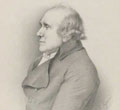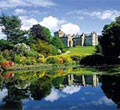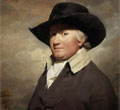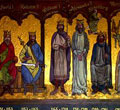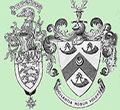Hunters Hall of Fame
Alexander to Anne
Alexander Hunter, M.D. (1729-1809), physician, born at Edinburgh in 1729 (the Memoir says 1733), was eldest son of a druggist in good circumstances. He was sent to the grammar school at ten, and at fifteen to the university, where he remained until he was twenty-one, having devoted the last three years to medicine. He spent the next year or two studying in London, in Rouen (under Le Cat), and in Paris (under Petit), and on his return to Edinburgh graduated M.D. in 1753 (thesis, 'De Cantharidibus'). After practising for a few months at Gainsborough, and a few years at Beverley, he was invited to York in 1763, on the death of Dr. Perrot, and continued to practise there with great success until his death in 1809.
His first literary venture was a small tract in 1764, an 'Essay on the Nature and Virtues of the Buxton Waters,' which went through six editions. The last appeared in 1797 under the name of 'The Buxton Manual.' In 1806 he published a similar work on the 'Waters of Harrowgate,' York, 8vo.
He took an active part in founding the Agricultural Society at York in 1770, and to give respectability to the institution, he prevailed on the members to reduce their thoughts and observations into writing. These essays, on the food of plants, composts, &c., were edited by him in four volumes (London, 1770-2), under the title of 'Georgical Essays,' and were so much valued as to be reprinted three times (once at London and twice at York) before 1803. His 'New Method of Raising Wheat for a Series of Years on the Same Land' appeared in 1796, York, 4to.
In 1772 Hunter set to work to establish the York Lunatic Asylum. The building was finished in 1777, and Hunter was physician to it for many years.
His continued interest in rural economy was shown in an elaborate illustrated edition, with notes, of Evelyn's; 'Sylva,' in 1 vol. 4to, 1776 (reprinted in 1786, in 2 vols. in 1801, and again, after his death, in 1812). In 1778 he edited Evelyn's 'Terra,' and joined it to the third edition of the 'Sylva,' 1801. He was elected F.R.S. (Lond.) in 1775, and F.R.S. (Edinb.) in 1790. He was also made an honorary member of the Board of Agriculture, and in 1795 addressed a pamphlet to Sir John Sinclair on 'Outlines of Agriculture ' (2nd edit. 1797). In 1797 he published 'An Illustration of the Analogy between Vegetable and Animal Parturition,' London, 8vo. He was author of a tract on the curability of consumption, extracted from the manuscript of William White of York, of which a French translation by A. A. Tardy (London, 1793 ) is known; and also of a cookery-book, called 'Culina Famulatrix Medicinae.' first published in 1804, reprinted in 1805, 1806, and 1807, and finally in 1820 under the title 'Receipts in Modern Cookery.' A production of his old age, which became well known, was a collection of maxims called 'Men and Manners; or Concentrated Wisdom.' It quickly reached a third edition in 1808. The last edition contains 1,146, maxims, chiefly trite and good, but mixed with a few of inferior quality, which have every appearance of being original. He died on 17 May 1809, and was buried in the church of St. Michael le Belfry at York. He was twice married, first, in 1765, to Elizabeth Dealtry of Gainsborough, by whom he had two sons and one daughter, who pre-deceased him, and secondly, in 1799, to Anne Bell of Welton, near Hull, who survived him.
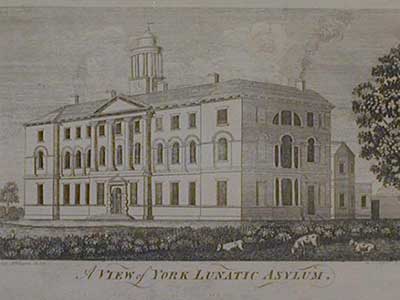
at the planning stage
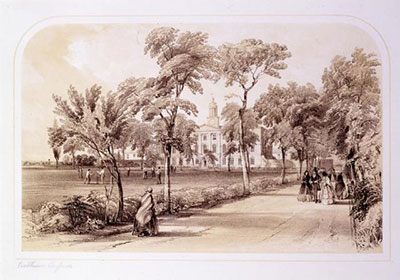
when completed
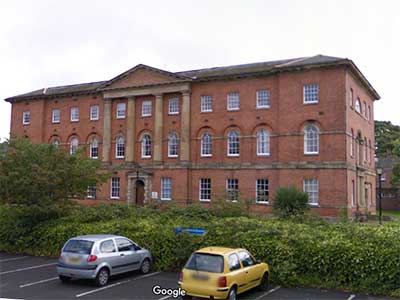
how it looks today
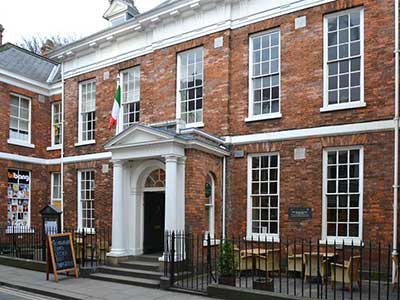 Alexander's final house, nowadays a restaurant
Alexander's final house, nowadays a restaurant
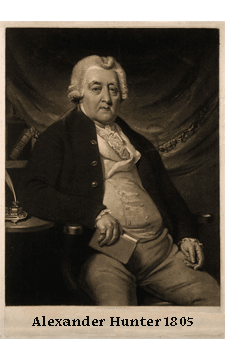
In 1790 there was a food scarcity in England and a group of five ex-Edinburgh medical fellows rallied to the fore. Known as the The Edinburgh Circle, it included Alex. and an Erasmus Darwin. Erasmus was the grandfather of the later renowned Charles Darwin. Charles surprisingly did not study biology or natural history but was enrolled initially at Edinburgh University to study medicine.
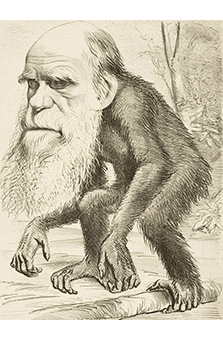
The book Evelyn's Silva was an outstanding book of it's time. The first comprehensive study of U.K. trees. It was initially printed in 1662. The last edition was printed in 1729 and fifty years after it's writer had died it was losing it's popularity. The Royal Society asked Alexander, who had proved his literary prowess and knowledge of agriculture, if he could revise and update such an important reference. Which he did, as a hobby, altering and updating as the science had advanced. The book is still today used as a reference and was a guidline to the planting and cultivation of most Victorian estates that can still be seen today.
When Alexander pushed for the building of a hospital to cure / help the mentally sick this was still a revolutionary idea and it became one of only five such "new" establishments in the country. He became the sole physician and served in that post until his death 32 years later.
One of Alex.'s cookbooks from 1810Andrew Hunter D.D. of Barjarg, 1743-1809, professor of divinity at Edinburgh, born in Edinburgh in 1743, was the eldest son of Andrew Hunter of Park, writer to the signet, of the Abbotshill branch of Hunters of Hunterston, Ayrshire. His mother was Grizel, daughter of General Maxwell of Cardoness in the stewartry of Kirkcudbright.
After an education at a private school in Edinburgh, he passed to the university, where he completed the usual course of study in arts and divinity. He subsequently spent a year at the university of Utrecht studying theology. He was licensed as a preacher by the presbytery of Edinburgh in 1767, but, unwilling to be separated from his father, he declined for some years to accept a pastoral charge.
During this period he was an active member of several literary and theological societies, and his reading and studies were directed by Robert Walker [q.v.] of the High Church, Edinburgh, the colleague of Dr. Blair, and one of the best preachers of the time. In 1770 he was ordained, and inducted as minister of the New Church, Dumfries, and soon afterwards he purchased the estate of Barjarg in that county.
He was translated to New Greyfriars Church, Edinburgh, in 1779, and at the same time was appointed colleague and successor to Dr. Robert Hamilton in the professorship of divinity in the university. In 1786 he was translated to the Tron Church, was moderator of the general assembly in 1792, declined soon afterwards the offer of a royal chaplaincy, and died 21 April 1809.
He was a prominent member of the evangelical section of the church. Inheriting an ample fortune, he taught the divinity class without remuneration as long as Dr. Hamilton lived, often helped poor students with pecuniary aid, and gave largely to the charitable and religious enterprises of the time.
He married in 1779 Marion Shaw, eldest daughter of William, sixth lord Napier, by whom he had:--
- William Francis, advocate, who took the additional name of Arundel, and succeeded to the estate of Barjarg
- John, D.D., minister of Swinton, and afterwards of the Tron Church, Edinburgh
- Grizel, who married George Ross, esq., advocate
Hunter published three separate sermons (1775, 1792, and 1797). Two other of his sermons are in the 'Scottish Preacher.'
[Scott's Fasti; Bower's Univ. of Edinb.; Kay's Portraits; Anderson's Scottish Nation.]
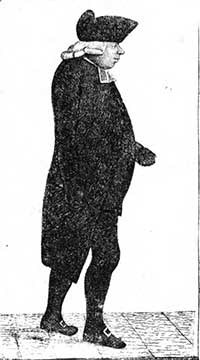 Andrew who rose from minister to Moderator of the General Assembly was a prime target for satire
Andrew who rose from minister to Moderator of the General Assembly was a prime target for satire
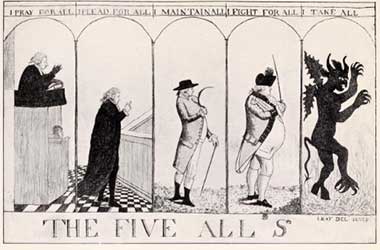 Andrew on the left
Andrew on the left
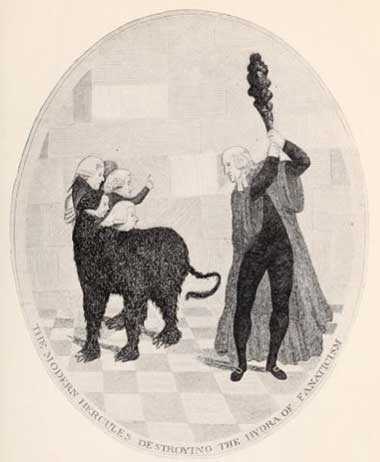 and again, John Kay put Andrew as the lower head
and again, John Kay put Andrew as the lower head

On the Hunter front Andrew brought in a new era he was the last Hunter to live at Abbotshill, which had been the family home for over 200 years. As he was sent to a church in Dumfriesshire he purchased Barjarg Tower in 1772.
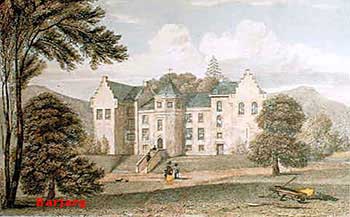
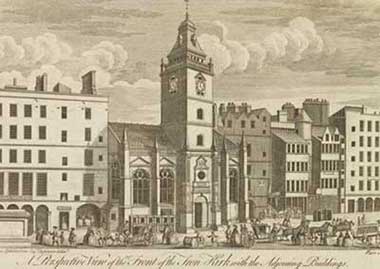
In 1639 there was a period known as the Bishop's Wars. King Charles 1st was in favour of the Episcopal system of church government. He appointed a Bishop to the High Kirk and it was known as St Giles Cathedral. In retaliation the congregation of the High Kirk commissioned a new church to be built 150 yards down the road. The Tron Kirk, between the Royal Mile and Hunter Square was started in 1636 and completed by 1647.
Anne Hunter (1742-1821), poetess, eldest daughter of Robert Home, surgeon, and sister of Sir Everard Home [q.v.], married in July 1771 John Hunter [q.v.] the great surgeon.
Before her marriage she had gained some note as a lyrical poetess, her 'Flower of the Forest" appearing in 'The Lark,' an Edinburgh periodical, in 1765. Her social literary parties were among the most enjoyable of her time, though not always to her husband's taste. Elizabeth Carter and Miss Delany were her attached friends, and Haydn set a number of her songs to music, including 'My Mother bids me bind my Hair' originally written to an air of Pleydell's.
On her husband's death in 1793, Mrs. Hunter was left ill provided for, and for some time she was indebted for a maintenance partly to the queen's bounty and to the generosity of Dr. Garthshore (1732-1812), and partly to the sale of her husband's furniture, library, and curiosities (OTTLEY, Life of Hunter, pp. 137-9). In 1799 parliament voted £15,000 for the Hunterian museum, which placed Mrs. Hunter in fair circumstances.
She had four children, of whom two, a son and a daughter (wife of Sir James Campbell), survived her. She lived in retirement in London till her death on 7 Jan. 1821. Her poems (12mo, London, 1802 ; 2nd edition, 1803) show no depth of thought, but have a natural feeling and simplicity of expression, which make many of them worth reading (see British Critic, October 1802, pp. 409-13). Her 'Sports of the Genii,' written in 1797 to a set of graceful drawings by Miss Susan Macdonald (d. 1803), eldest daughter of Lord-chief-baron Macdonald, display in addition humour and fancy.
[Gent. Mag. 1821, vol. xei. pt. i. pp. 89, 90; also in Nichols's Lit. Illustr. vii. 638, by Arch-deacon R. Napes ; Lives of John Hunter; Charles Rogers's Modern Scottish Minstrel, 1855, i. 39, 40.]
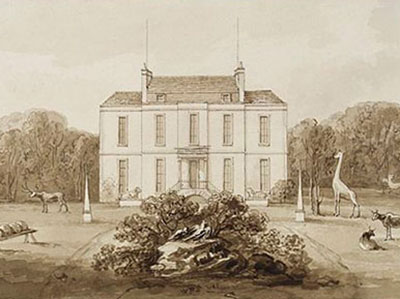
Earls Court, one of their first houses together. Where John kept his larger animal menagerie.
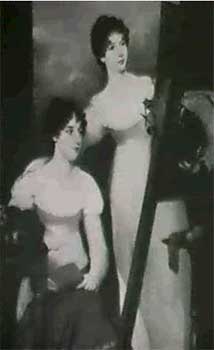
Anne and her younger sister Mary, painted by her brother Robert Home.
Robert Home, Annes father, had joined the army in 1760 and was serving as a surgeon in General Burgoyne's Regiment of Horse.
In 1761 the regiment went to Belle-Île, an island of the French coast. There he met John Hunter who was serving as staff surgeon.
In 1763 with the war ending both men returned to London. Anne was down from Scotland keeping house for her father, when she fell seriously ill and was treated by John.
They got engaged one year later but it was to be 7 years before they finally get married in 1771. Anne was 29 and John was 43.
John died in 1793 leaving Anne, a poor widow at the age of 51.
Anne sought her poetry for comfort and in 1794 collaborated with Franz Joseph Haydn. Haydn only published 12 songs in English and Anne wrote the words of at least 9. Some of which are still around today. Over 200 years later.
Anne's health had been failing these last few years and she passed away on a cold January morning in 1821, at the age of 79.

